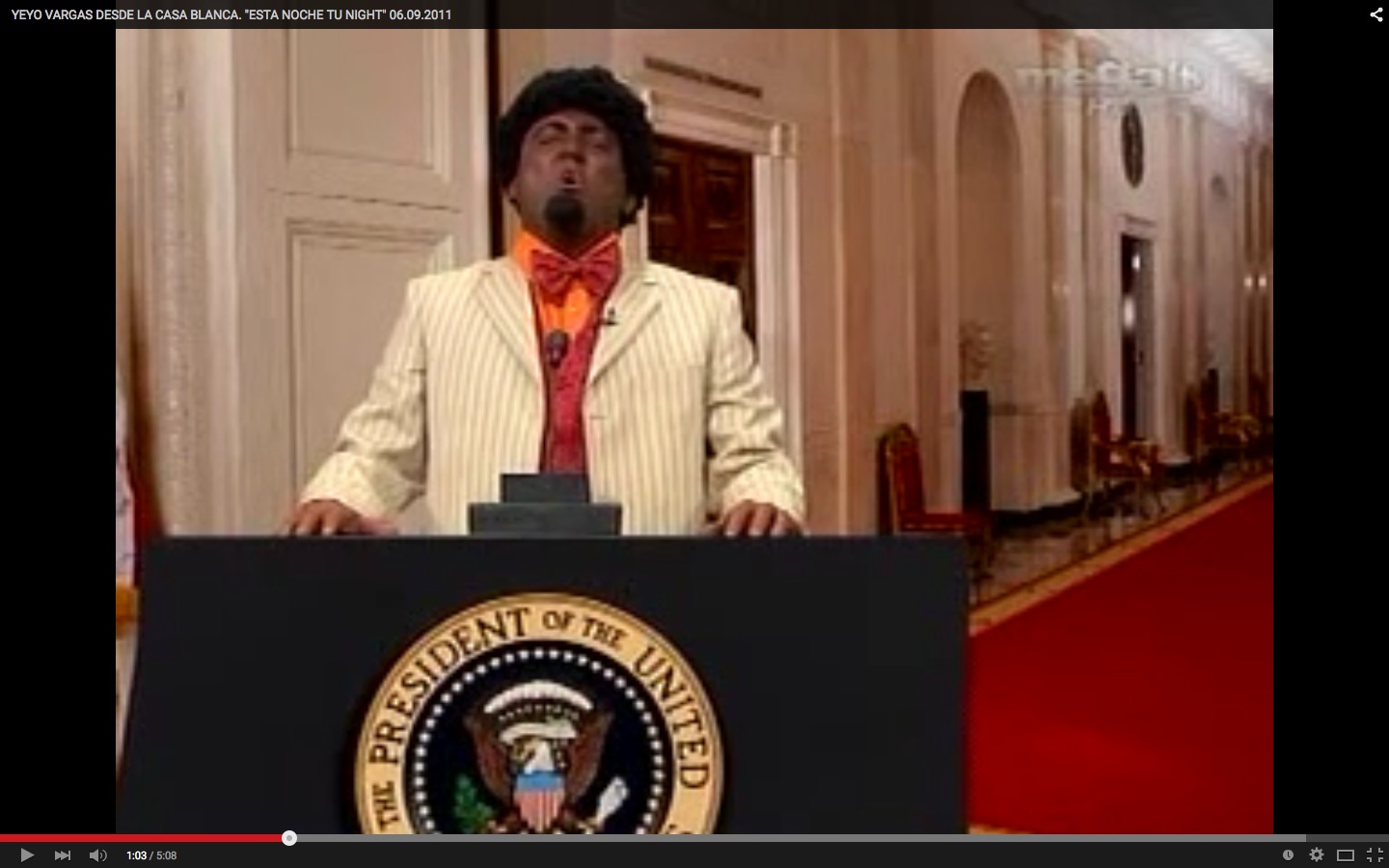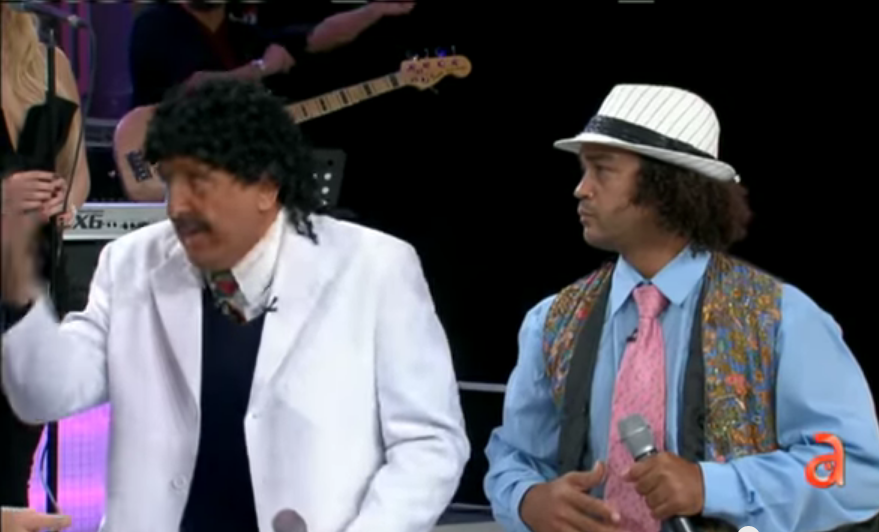Meet Yeyo Vargas, Miami’s foremost Latino: the president of the ULPO (Latino Union Party), which arguably represents the interests of Latinos, particularly Democrat Afro-Latinos. He is, by his own account, El Tigre Barack Obama’s right hand; his advisor for Latin American and Caribbean affairs, including those of the Major, Minor, and Tiny Antilles. Obama and he often chat on the phone, and he is a frequent visitor to the White House. Yeyo is Afro-Dominican, a brown Latino, and he likes Cuban women, particularly the bleached blond surgery-enhanced vedette Niurka Marcos. She, however, does not reciprocate: she only fancies one “negro” and that is president Obama, Yeyo’s boss.
Between 2010 and 2012, Yeyo Vargas was a regular on Esta Noche Tu Night, Cuban comedian Alexis Valdés’ show on Miami-based Mega TV. Indeed, Yeyo is a Dominican for Cuban consumption: he is impersonated by a white Cuban donning brownface. While he is no longer on the air, Yeyo is not the only brown Dominican that Miami Cuban comedians have created: the Merengueros Dominicanos continue to make the Cuban audience laugh with their crass sexual dancing and vulgar lyrics. But Yeyo is for sure the most powerful. As a presidential advisor, he represents not only himself but so-called Latinos — and there lies the question. Why do recent, Spanish-speaking, working-class Cuban immigrants see a brown Dominican as the comedic embodiment of Latinidad? And why do they not use a brown Dominican but instead resort to a performative device –blackface- that is so intertwined with racism in the U.S.?
The Brownness of Latinidad
Blackface – a facial darkening for the purposes of racial or ethnic mockery – is not new for Cubans. In Cuba, like in the United States, blackface performances originated in the 19th century in response to slaves and ex-slaves’ demands for emancipation and inclusion. The 1959 Revolution in Cuba, like the Civil Rights Movement in the U.S., eclipsed them at least from television. Cuban blackface minstrels, however, found a welcome in exile. First in Puerto Rican television –as documented by Yeidy Rivero in Tuning Out Blackness – and later in 2000s Miami, Cubans have used blackface to comment on a new society structured by class and race. The more they themselves have been represented in the U.S. media as brown (recall Scarface, and more recently, Paula Deen’ son as Ricky Ricardo) the more they have claimed a whiteness that should grant them inclusion and a path for upward mobility. In Miami, no matter their immigrant cohort, Cubans report overwhelmingly (over 95%) as white. But while their position in a white and black world is unambiguous, their relation to a hybrid, or brown Latinidad, is far more complicated.
In a city like Miami, where Latin American-born immigrants and their descendants are the absolute majority, assigning them all to a blanket category like Hispanic or Latino loses all purpose.
More often, they prefer to identify themselves according to their nationality, particularly given the national basis of social networks and social capital –a phenomenon recently identified by the Pew Research Center. In this double context: —a multicultural mosaic of nationalities, and a claim to whiteness, —South Florida Cubans and South Americans reject the renditions of Latinidad, often generated by Puerto Ricans and Chicanos, that assign “color” to Latinos. The 20th century struggles of more established groups are alien to these so-called Latinos in South Florida. Dominicans in Miami, by and large, are no exception, identifying mostly as white and middle class. Those in the Northeast, however, have not hesitated to partake of the Latinidad defined by Puerto Ricans and Mexicans.
And here is where Yeyo Vargas comes in. Cubans “brown” or “darken” Dominicans only to situate them in high office, close to President Obama, like many Dominicans himself a black man of mixed heritage. In this context, blackface and brownface mark not only a distance from blackness, but, most importantly, a distance from Latinidad and its avenues for upward mobility and access to power that remain alien to working class Cubans.
Yeyo Vargas, Johnny Ternura, and Coño Rosario
Blackface, or brownface, paired with ethnic satire, entails a peculiar dynamic of intimacy and distance, of endearment and rejection. Ultimately, it represents an attempt to work through the social contradictions of the new society, by putting them under a racial lens. This is very evident in the aforementioned skits of the Dominican Merengueros, a duo formed by a Johnny Ternura and a Coño Rosario played by two Cuban actors, one of whom dons brownface (the other is “brown” himself). Their Dominican vocabulary constantly leads to double-entendres in Cuban Spanish, usually sexual. Their dancing style, rather than displaying the sensuality expected from Cuban dance music, is jerky and crass, often imitating sexual moves associated with animals.
The merengueros are city slickers. In every episode they present a song, often only differing from all others by its lyrics. In one, they sing about their own drug bust, at a traffic stop, when the duo futilely argued that the powder found in their trunk was not cocaína but aspirina. Carlos Otero, the Cuban show host, invariably kicks them out of the stage for their lewdness and lack of decency, offensive to the supposedly refined Cuban audience. There is an element of self-deprecation there too that speaks to Cuban aspirations of respectability on its road to middle-class whiteness.
But the core of the comedy is to differentiate Cubans from Dominicans in terms of race and manners, while pointing at the paradox of class. Yeyo is a prime example. His costume (a big afro, darker skin, and an elegant suit with bright colors), his accent and speech patterns (“cibaeño”), and the merengue music that always accompanies him unequivocally inscribes him socially. Thus, what do Yeyo Vargas, Johnny Ternura, and Coño Rosario represent for the audiences who sit in front of the TV and watch their comedic performances?
First, to new immigrants, specifically Cubans coming from the island, these characters represent acculturation, albeit in different ways. While the merengueros are urban hustlers and as such remain at the fringes of society, Yeyo has been able to achieve respectability thanks to being an honest “guajiro,” a peasant. That is clear in his speech (cibaeño), from a rural area of the Dominican Republic, sprinkled with the malapropisms identified with the negrito catedrático in Cuban minstrel theater — the urban black man who imitates the speech of educated whites. His mannerisms and speech index his poor educational and class background, yet he has fared very well. Why? Because of his color. He signifies a new racial regime that baffles many recent Cuban immigrants for whom whiteness should hold the key to upward mobility. Yeyo’s success: to have the President’s ear and therefore a voice in Washington. He is Obama’s right hand in addition to being of his same color. In a context in which political power in Washington has been long associated with the Republican Party and the likes of Ileana Ros-Lehtinen, Mario Diaz-Balart and Marco Rubio, all educated, white Cubans, it is Yeyo who stands for the unlikely, immigrant dream. And that is precisely what is subjected to laughter.
Second, Yeyo represents Latinidad; or at least a form of brown Latinidad, from which first and second generation immigrant Venezuelans, Colombians, South Americans, Cubans and Spaniards in Miami are racially estranged. Yeyo’s Latinidad is one often claimed by Mexicans, as well as by Puerto Ricans, who have a longer presence in the United States as internally colonized populations, and who have never been classified as white. The mostly working-class, non-white Dominicans who settled in areas of heavy Puerto Rican presence in the Northeast have been able to ease into the Latino category, unlike their white middle-class co-nationals in Miami. For the recently-arrived Cuban television writers who author Yeyo’s and the Merenguero’s scripts, brown Dominicans are safe to mock before a local Miami audience that mostly excludes them. Yet these seemingly-acculturated Dominicans are part of a dialogue between Caribbeanness and Latinidad that is intriguing in its difference from a Cuban immigrant perspective, in terms of labor relations, class, and immigration status. Paradoxically, Cubans’ fast path to U.S. citizenship as former communist subjects does not render them the kind of American subject that Latinos are expected to be. Cuban immigrants, with these sketches, distrust a stereotype of Latinidad that does not belong to them.
It Takes a Performance to Unmask a Performance: Closing Remarks
The impersonation of brown Dominicans by white Cubans shows the conflict derived from long-held assumptions about race (whiteness) and class (middle), and their correlation with assimilation into the U.S. mainstream. Yeyo Vargas, like his merenguero co-nationals, is a wannabe: one who pretends to be what he is not and in the process he may fool some – in this case President Obama. Brownface is used then, to represent a Latino success that is mocked as based on thin air. Neither do the merengueros have talent nor Yeyo Vargas education. Yeyo Vargas, more so than the merengueros, represents a world upside down: one in which people of color can make it to the top, regardless of education and class.
Through these characters, Cubans are struggling to come to terms with a Latinidad that they did not know before setting foot in the U.S. They see Dominicans, like Mexicans and Puerto Ricans, negotiating it and, in most cases, embracing it. But post-Soviet Cuban immigrants, also alienated from the exile success story, are left outside the project of their adopted nation. It is through racial comedy that they strike back, denouncing the brown Latinidad represented by both the Dominican city slickers and presidential advisors as nothing other than pure politics. Blackface, in this context, operates not as a mask but as the unmasking of what appears to them as theatrics: the performance of Latinidad.
* Cover photo is a screen shot corresponding to “Yeyo Vargas from the White House requesting funds for Obama’s campaign” (aired on Esta Noche Tu Night, on Mega TV, 6/09/2011).



